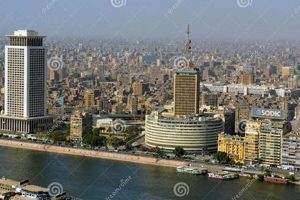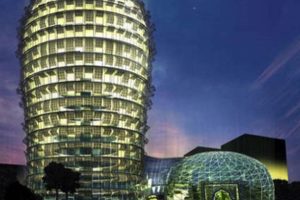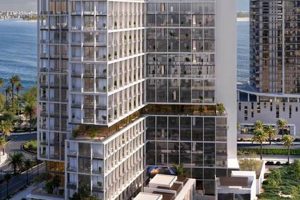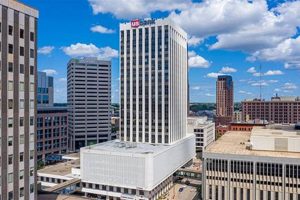Skyscrapers are tall, multi-story buildings that are designed to house a variety of uses, including residential, commercial, and office space. Skyscrapers are often built in urban areas where land is scarce and there is a need for high-density housing and commercial development. Boston is a city with a rich history and a thriving economy, and it is home to a number of notable skyscrapers.
One of the most iconic skyscrapers in Boston is the John Hancock Tower, which was completed in 1976. The John Hancock Tower is the tallest building in Boston and New England, and it offers stunning views of the city and the surrounding area. Another notable skyscraper in Boston is the Prudential Tower, which was completed in 1964. The Prudential Tower is the second tallest building in Boston, and it is home to a variety of businesses and retail stores.
Skyscrapers play an important role in the Boston skyline and economy. They provide much-needed housing and commercial space in a densely populated area, and they contribute to the city’s overall economic vitality. Skyscrapers are also a popular tourist destination, and they offer visitors a unique perspective of the city.
1. Height
The height of Boston’s skyscrapers is a major contributing factor to the city’s skyline and overall identity. The John Hancock Tower, which stands at 790 feet tall, is the tallest building in New England and the 18th tallest building in the United States. Other notable skyscrapers in Boston include the Prudential Tower (741 feet), the Federal Reserve Bank Building (614 feet), and the Custom House Tower (529 feet). These buildings are all iconic landmarks that contribute to Boston’s unique skyline.
The height of Boston’s skyscrapers is also important for the city’s economy. Tall buildings can accommodate more tenants and businesses, which can lead to increased economic activity. In addition, tall buildings can be used to attract tourists and businesses to the city. For example, the John Hancock Tower is a popular tourist destination, and it is also home to a number of businesses, including law firms, financial institutions, and technology companies.
Overall, the height of Boston’s skyscrapers is an important factor for the city’s skyline, economy, and identity. Tall buildings contribute to the city’s unique character and help to attract tourists and businesses.
2. Architecture
The architecture of Boston’s skyscrapers is a reflection of the city’s rich history and diverse culture. The city’s first skyscrapers were built in the late 19th and early 20th centuries, and they were designed in a variety of architectural styles, including Romanesque Revival, Gothic Revival, and Beaux-Arts. In the mid-20th century, Boston saw a boom in skyscraper construction, and many of the city’s most iconic skyscrapers were built during this time. These skyscrapers were designed in a variety of modern styles, including Art Deco, International Style, and Brutalist. In recent years, Boston has seen a new wave of skyscraper construction, and these new skyscrapers are designed in a variety of contemporary styles.
- Art Deco: Art Deco is a style of architecture that was popular in the 1920s and 1930s. Art Deco buildings are characterized by their sleek lines, geometric shapes, and decorative details. Some of the most notable Art Deco skyscrapers in Boston include the John Hancock Tower, the Prudential Tower, and the Custom House Tower.
- International Style: The International Style is a style of architecture that was popular in the 1950s and 1960s. International Style buildings are characterized by their simple lines, lack of ornamentation, and use of glass and steel. Some of the most notable International Style skyscrapers in Boston include the Federal Reserve Bank Building and the One Boston Place building.
- Brutalist: Brutalist is a style of architecture that was popular in the 1960s and 1970s. Brutalist buildings are characterized by their raw concrete exteriors and their emphasis on form over function. Some of the most notable Brutalist skyscrapers in Boston include the Boston City Hall and the Christian Science Center.
- Contemporary: Contemporary architecture is a style of architecture that is characterized by its use of new materials and technologies. Contemporary skyscrapers in Boston are often designed with sustainability in mind, and they may feature green roofs, solar panels, and other energy-efficient features. Some of the most notable contemporary skyscrapers in Boston include the Millennium Tower and the Torre.
The variety of architectural styles in Boston’s skyscrapers is a reflection of the city’s diverse history and culture. The city’s skyscrapers are a source of pride for Bostonians, and they are a major tourist attraction. The next time you are in Boston, be sure to take some time to admire the city’s skyscrapers and their unique architecture.
3. Location
The location of Boston’s skyscrapers is an important factor in their overall impact on the city. Skyscrapers are typically built in areas with high land values and good access to transportation. In Boston, skyscrapers are concentrated in the Financial District, Back Bay, and Seaport District. These neighborhoods are all centrally located and offer easy access to public transportation, making them ideal locations for businesses and residents.
- Financial District: The Financial District is home to many of Boston’s banks, investment firms, and other financial institutions. The John Hancock Tower, Prudential Tower, and Federal Reserve Bank Building are all located in the Financial District. These skyscrapers provide office space for thousands of workers and contribute to the city’s economy.
- Back Bay: Back Bay is a residential and commercial neighborhood located just south of the Financial District. Back Bay is home to many of Boston’s most prestigious schools and universities, as well as a number of luxury condos and apartments. The Hancock Place building and the Four Seasons Hotel Boston are both located in Back Bay.
- Seaport District: The Seaport District is a relatively new neighborhood located on the waterfront. The Seaport District is home to a number of luxury apartments and condos, as well as a number of restaurants, shops, and businesses. The Millennium Tower and the Pier 4 building are both located in the Seaport District.
The location of Boston’s skyscrapers has a number of implications for the city. First, the concentration of skyscrapers in the Financial District, Back Bay, and Seaport District creates a sense of density and energy in these neighborhoods. Second, the location of skyscrapers
in these neighborhoods makes them easily accessible to workers and residents. Third, the presence of skyscrapers in these neighborhoods contributes to the city’s overall economic vitality.
4. Use
Boston’s skyscrapers are used for a variety of purposes, including residential, commercial, and office space. This diversity of use is a major factor in the city’s economy and quality of life. Residential skyscrapers provide housing for thousands of people, while commercial skyscrapers house businesses and retail stores. Office skyscrapers provide space for workers in a variety of industries. The mix of uses in Boston’s skyscrapers creates a vibrant and diverse urban environment.
The use of skyscrapers for residential purposes is a relatively recent development in Boston. In the early 20th century, skyscrapers were primarily used for commercial and office space. However, in the 1960s and 1970s, a number of residential skyscrapers were built in Boston, including the John Hancock Tower and the Prudential Tower. These buildings were designed to meet the demand for housing in the city’s growing population. Today, residential skyscrapers are an important part of the Boston skyline and provide housing for a diverse population.
Commercial skyscrapers are another important part of the Boston economy. These buildings house a variety of businesses, including banks, law firms, and technology companies. The concentration of businesses in skyscrapers creates a dense and vibrant urban environment. Commercial skyscrapers also contribute to the city’s tax base and provide jobs for thousands of people.
Office skyscrapers are the most common type of skyscraper in Boston. These buildings provide space for workers in a variety of industries, including finance, insurance, and technology. The concentration of office space in skyscrapers creates a dense and efficient urban environment. Office skyscrapers also contribute to the city’s tax base and provide jobs for thousands of people.
The diversity of use in Boston’s skyscrapers is a major factor in the city’s economy and quality of life. Residential skyscrapers provide housing for thousands of people, commercial skyscrapers house businesses and retail stores, and office skyscrapers provide space for workers in a variety of industries. The mix of uses in Boston’s skyscrapers creates a vibrant and diverse urban environment.
5. History
The construction of the Ames Building in 1893 marked a significant milestone in the history of skyscrapers in Boston. Prior to this, buildings in the city were typically low-rise structures, but the Ames Building, with its 12 stories, was the first to break this mold.
- Architectural Innovation: The Ames Building showcased innovative architectural techniques that would become commonplace in later skyscrapers. Its steel frame construction allowed for a taller and more slender building than had previously been possible, and its large windows provided ample natural light for its occupants.
- Technological Advancements: The construction of the Ames Building coincided with advancements in elevator technology, which made it possible for people to reach higher floors quickly and efficiently. This technological advancement was essential for the development of taller skyscrapers.
- Symbol of Progress: The Ames Building was seen as a symbol of Boston’s growing prosperity and ambition. Its construction reflected the city’s desire to embrace modernity and compete with other major cities in the United States.
- Influence on Later Skyscrapers: The Ames Building served as a model for subsequent skyscrapers in Boston and beyond. Its design and construction techniques were adopted by other architects and engineers, and it helped to shape the development of the modern skyscraper.
The Ames Building’s legacy extends beyond its architectural significance. It played a pivotal role in transforming Boston’s skyline and paving the way for the city’s continued growth and development. As Boston continued to grow in the 20th century, numerous other skyscrapers were constructed, each contributing to the city’s unique architectural identity.
6. Culture
Skyscrapers have become iconic symbols of Boston’s skyline and a major attraction for tourists visiting the city. Their towering heights and architectural designs offer visitors a unique and unforgettable experience, contributing to Boston’s rich cultural tapestry.
- Architectural Marvels: Boston’s skyscrapers showcase a diverse range of architectural styles, from Art Deco to modern, creating a visually stunning urban landscape. Visitors can admire the intricate details and innovative designs of these architectural marvels, gaining an appreciation for the city’s architectural heritage.
- Observational Decks: Many of Boston’s skyscrapers feature observation decks that offer panoramic views of the city and its surroundings. These decks provide visitors with a bird’s-eye perspective, allowing them to capture the city’s beauty and landmarks from a unique vantage point.
- Historical Significance: Boston’s skyscrapers have played a significant role in the city’s history and development. The construction of the Ames Building in 1893 marked the beginning of Boston’s skyscraper era, and subsequent skyscrapers have continued to shape the city’s skyline and identity.
- Cultural Landmarks: Skyscrapers have become cultural landmarks in Boston, symbolizing the city’s progress and economic vitality. They have been featured in numerous films, television shows, and works of art, further solidifying their place in the city’s cultural consciousness.
In conclusion, Boston’s skyscrapers are not only architectural marvels but also significant cultural attractions. They offer visitors a unique perspective of the city, showcasing its architectural diversity, historical significance, and cultural vibrancy. As Boston continues to grow and evolve, its skyscrapers will undoubtedly remain a central part of the city’s cultural fabric.
7. Economy
Skyscrapers play a significant role in the economic landscape of Boston, contributing to the city’s financial well-being through job creation and tax revenue generation. Here are key details exploring this connection:
- Job Creation: Boston’s skyscrapers provide a substantial number of employment opportunities. They house businesses, corporations, and organizations of various sizes, offering a wide range of professional and administrative positions. These jobs contribute to the city’s workforce and support the livelihoods of many individuals.
- Tax Revenue: Skyscrapers contribute significantly to Boston’s tax base. The property taxes levied on these buildings generate substantial revenue for the city. This revenue helps fund essential public services, such as education, infrastructure, and healthcare, benefiting the entire community.
- Economi
c Growth: The presence of skyscrapers attracts businesses and investments to Boston. Companies seeking a prestigious and central location often choose to establish their headquarters or offices in skyscrapers. This influx of businesses fosters economic growth by creating new job opportunities and stimulating business activity. - Increased Property Value: Skyscrapers positively impact surrounding property values. The desirability of being near these landmarks and business hubs often leads to increased demand for nearby properties. This appreciation in property value benefits homeowners, investors, and the city as a whole.
In conclusion, Boston’s skyscrapers serve as economic engines for the city. They provide employment opportunities, generate tax revenue, stimulate economic growth, and enhance property values. As a result, they play a vital role in maintaining Boston’s financial stability and prosperity.
8. Sustainability
Skyscrapers, with their towering heights and vast energy consumption, have a significant impact on the environment. Recognizing this, Boston has emerged as a leader in sustainable skyscraper design, implementing innovative strategies to reduce their environmental footprint.
The incorporation of sustainability into Boston’s skyscrapers is a testament to the city’s commitment to environmental stewardship. Buildings like the Millennium Tower and the Torre employ cutting-edge technologies to minimize energy consumption and promote eco-friendliness. These measures include high-performance glazing to reduce heat gain, efficient lighting systems, and rainwater harvesting systems.
The benefits of sustainable skyscrapers extend beyond environmental protection. Green buildings have been shown to improve occupant well-being, reduce operating costs, and enhance the overall quality of life in urban areas. By embracing sustainability, Boston’s skyscrapers are not only contributing to a greener future but also creating healthier and more livable spaces.
The pursuit of sustainability in skyscraper design is an ongoing endeavor, with new advancements emerging regularly. As Boston continues to strive for a more sustainable future, its skyscrapers will undoubtedly serve as beacons of innovation and environmental consciousness.
9. Future
The continuous evolution of Boston’s skyline, marked by the construction of new skyscrapers, is an integral aspect of the city’s growth and modernization. This dynamic environment presents several key connections to the broader context of “skyscrapers in boston”:
- Architectural Innovation: Boston’s commitment to architectural innovation is evident in its ever-changing skyline. New skyscrapers showcase cutting-edge designs and incorporate sustainable features, pushing the boundaries of architectural possibilities and shaping the city’s identity.
- Economic Development: The construction of new skyscrapers often coincides with economic growth and prosperity. These buildings house businesses, attract investments, and create employment opportunities, contributing to the overall economic vitality of Boston.
- Changing Urban Landscape: The addition of new skyscrapers transforms Boston’s urban landscape, creating new landmarks and reshaping the city’s physical and visual character. These changes influence urban planning, transportation networks, and the overall livability of the city.
- Sustainability: As environmental awareness grows, new skyscrapers in Boston prioritize sustainability through energy-efficient designs, green building practices, and reduced environmental impact. This focus reflects the city’s commitment to creating a more sustainable future while embracing vertical development.
In conclusion, the continuous evolution of Boston’s skyline, with the construction of new skyscrapers, is inextricably linked to the city’s architectural innovation, economic development, urban transformation, and sustainability goals. These new additions to Boston’s skyline shape the city’s identity, contribute to its economic prosperity, enhance its urban character, and drive its progress towards a more sustainable future.
FAQs about Skyscrapers in Boston
This section addresses frequently asked questions and misconceptions surrounding skyscrapers in Boston, providing concise and informative answers.
Question 1: What is the tallest skyscraper in Boston?
The tallest skyscraper in Boston is the John Hancock Tower, standing at 790 feet tall with 60 stories.
Question 2: When was the first skyscraper built in Boston?
The first skyscraper in Boston was the Ames Building, completed in 1893 with 12 stories.
Question 3: How many skyscrapers are there in Boston?
There are over 100 skyscrapers in Boston, with more under construction or planned.
Question 4: Are skyscrapers in Boston safe?
Skyscrapers in Boston adhere to strict building codes and safety regulations, ensuring their structural integrity and resilience against various hazards.
Question 5: What are the benefits of skyscrapers in Boston?
Skyscrapers offer numerous benefits, including increased office space, efficient land use, stunning views, and economic growth.
Question 6: What is the future of skyscrapers in Boston?
Boston’s skyline is constantly evolving, with new skyscrapers incorporating sustainable designs, innovative technologies, and modern architectural styles.
In summary, skyscrapers in Boston are architectural marvels that contribute to the city’s skyline, economy, and overall identity. Their presence reflects Boston’s commitment to innovation, sustainability, and progress.
Proceed to the next article section…
Tips on Skyscrapers in Boston
To fully appreciate Boston’s skyscrapers and their impact, consider these informative tips:
Tip 1: Explore Architectural Styles:From Art Deco to modern, Boston’s skyscrapers showcase diverse architectural styles. Visit the John Hancock Tower for its Brutalist design and the Federal Reserve Bank Building for its International Style.
Tip 2: Ascend to Observation Decks:Experience breathtaking views from observation decks like the one at the Prudential Tower. Capture panoramic vistas of the city and surrounding landscape.
Tip 3: Discover Historical Significance:Understand the historical significance of Boston’s skyscrapers. Visit the Ames Building, the city’s first skyscraper, and learn about its architectural innovations.
Tip 4: Appreciate Economic Impact:Recognize the economic contributions of skyscrapers, providing employment opportunities, generating tax revenue, and stimulating business growth.
Tip 5: Embrace Sustainable Designs:Boston’s skyscrapers prioritize sustainability. Visit the Millennium Tower to witness energy-efficient materials and systems that minimize environmental impact.
Tip 6: Admire the Evolving Skyline:Boston’s skyline is constantly evolving with new skyscrapers. Stay updated on the latest architectural developments and witness the city’s transformation.
Tip 7: Respect Building Regulations:Skyscrapers adhere to strict
building regulations ensuring safety and structural integrity. Follow guidelines when visiting or working in these buildings.
Tip 8: Capture Memorable Moments:Don’t miss the opportunity to capture stunning photographs of Boston’s skyscrapers. Their grandeur and architectural details make for captivating images.
Remember these tips to enhance your exploration and understanding of skyscrapers in Boston, enriching your appreciation of their architectural, historical, and economic significance.
Proceed to the article’s conclusion…
Conclusion
Skyscrapers have become an integral part of Boston’s architectural landscape, economic vitality, and cultural identity. Their towering presence has reshaped the city’s skyline, offering stunning views and contributing to its unique character.
As Boston continues to grow and evolve, its skyscrapers will undoubtedly continue to play a significant role in the city’s future. They represent the city’s commitment to innovation, sustainability, and economic prosperity. By embracing architectural advancements and prioritizing sustainability, Boston’s skyscrapers will remain iconic symbols of the city’s progress and dynamism.







